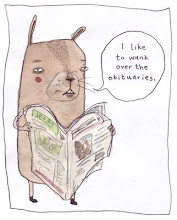
Pieter Brueghel's The Fall of the Rebel Angels depicts the fall from heaven of angels who have turned into all manner of freakish creatures and are seen tumbling into a pit at the bottom of the image. Brueghel had a wonderful way of making his monsters both frightful and faintly ridiculous with their wibbly flesh and comical expressions - are they scary or just silly? Whatever the case, you might think that they are hardly the kind of stuff that you might show to very young children. Yet the monster on the bottom right, which has had its egg-filled belly slashed open and is holding the gaping wound wide with an almost rapturous or pained expression on its face, appears on a spread from L'Arbre Merveilleux by Anne Herbauts. This is ostensibly a children's book but it is packed with difficult French and an eye for the dark and peculiar. I remember stumbling upon Brueghel's painting in the library whilst researching Hieronymus Bosch and Brueghel, and being quite taken aback when I made the connection to where I'd seen the image before - what a revelation it was to me that this lady had so boldly used such disturbing material as her inspiration.
On the previous spread it says (my rough translation):'Suddenly all these birds appear in the sky. Under the tree, the shadow of the magical egg is strange. Too big or too deep, too dark. Is it a stain, or could it be a hole? Monsieur Comme-Toujours asks himself. It's a chasm of mysteries, of metamorphoses! It is the unknown, the forgotten, the magical!'

The French is so poetic and suggestive of things much darker than the mere appearance of the image. Then you turn the page and you see that the birds are all a bit monstrous, with fish heads and bodies like mammals, and with Brueghel's eggy lady at the bottom tumbling into the shadow-chasm.

The story is pretty strange, involving a man who lives in a strictly regimented community made up of coffee pots, lighthouses and hot air balloons amongst other things. He angers the fairy who is in charge of the coffee pot house and ends up running off to 'see the country' with a little monster as his companion.

Along the way they encounter a monster with a bell for a head, a witch who cooks up fairytales from words, a little creature who lives in an apricot and a frog who serves them coffee whilst weeping because he has lost his memories.


What I love about Anne Herbauts' work, apart from her lovely, expressive style, is the way in which she tells stories through her pictures. A red thread - a 'story thread' runs like a vein throughout this book and there is a playfulness in the way that she uses it, for example when the little monster stitchs up the page with the red thread, representing the way in which narrative can be cut and joined up again, or stopped and re-started. The whole narrative is tied to the idea of creating stories, playing with words, and the way in which she links that idea to the very fabric of the book is wonderfully imaginative.

Enough talking. This is the only book of hers that I've got - anyone fancy buying me another?!












No comments:
Post a Comment